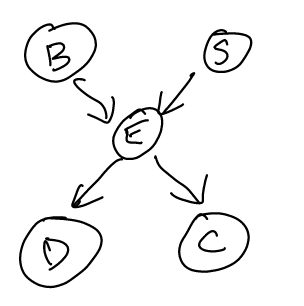Direct Sampling
Direct Sampling is an approximate inference method where we pull samples from the given joint probability distribution.
Example
Suppose we are interested in:

where we dare \(P(B^{1}|D^{1},C^{1})\).
Step 1: sort
We obtain a topological sort of this network:
\begin{equation} B, S, E, D, C \end{equation}
Step 2: sample from \(B,S\)
- We sample \(B\). We sampled that \(B=1\) today.
- We sample \(S\). We sampled that \(S=0\) today.
Step 3: sample from \(E\)
- We sample \(E\) GIVEN what we already sampled, that \(B=1, S=0\), we sampled that that \(E = 1\)
Step 4: sample from \(D, C\)
- We sample \(D\) given that \(E=1\) as we sampled.
- We sample \(C\) given that \(E=1\) as we sampled.
Repeat
Repeat steps 2-4
Step n: Analyze
| B | S | E | D | C |
|---|---|---|---|---|
| 1 | 0 | 1 | 0 | 1 |
| 0 | 1 | 1 | 0 | 0 |
| 1 | 1 | 1 | 1 | 0 |
| 0 | 0 | 1 | 1 | 0 |
| 1 | 0 | 1 | 1 | 1 |
We desire to know \(P(b^{1}|d^{1}, c^{1})\). Looks like, given this table, it would be \(100\%\).
Likelihood Weighted Sampling
Likelihood Weighted Sampling is a sampling approach whereby you force values that you wont, and then weight the results by the chance of it happening.
This is super useful when our envidence is unlikely.
Example
Suppose again you are interested in \(P(b^{1}|d^{1}, c^{1})\). In this case, we only sample \(B,S,E\):
| B | S | E |
|---|---|---|
| 0 | 1 | 0 |
| 1 | 0 | 1 |
Now, for each of these results, we the compute the chance of our priors happening given the samples.
- Row 1: \(p(d^{1}|e^{0})p(c^{1}|e^{0})\)
- Row 2: \(p(d^{1}|e^{1})p(c^{1}|e^{1})\)
Let’s say:
- Row 1: \(p(d^{1}|e^{0})p(c^{1}|e^{0})=0.3\)
- Row 2: \(p(d^{1}|e^{1})p(c^{1}|e^{1})=0.9\)
Finally, to compute \(p(b^{1}|d^{1}c^{1})\):
\begin{equation} \frac{0.9}{0.9+0.3} \end{equation}
because only row \(2\) fit with our expectations.